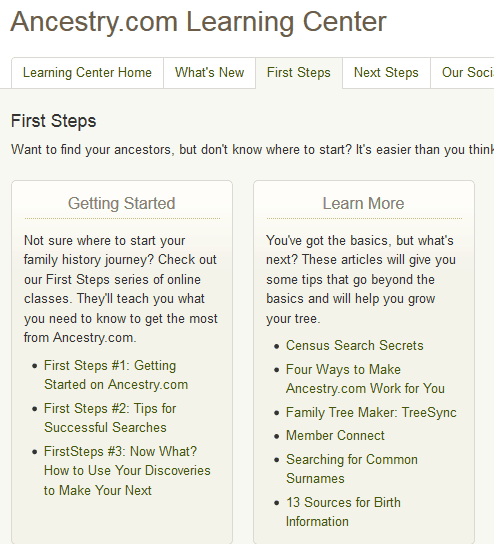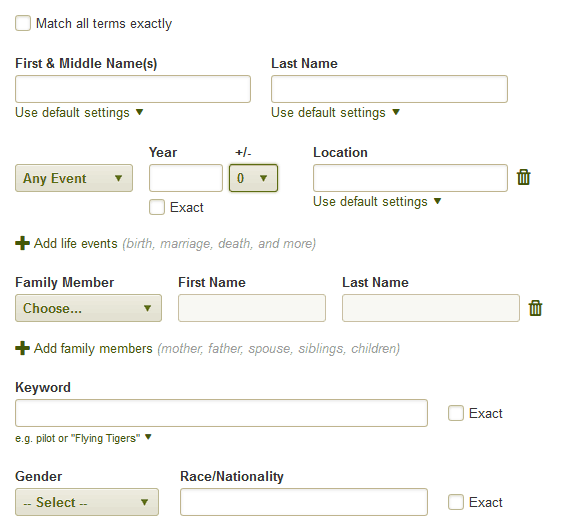Article source: What is Ancestry.com by TechBoomers.com
How well do you know your family’s history? Have you ever asked yourself: “Who were my ancestors?” “Where were they originally from?” “What did they do for a living?” “When did they decide where to go and how did they get there?” “Was one of them perhaps someone famous, or did they have a famous descendant?”
If you’ve ever wondered about these types of questions, check out Ancestry.com.
So what exactly is Ancestry.com?
Ancestry.com is the largest private online genealogy database. It allows users to create virtual family trees to trace their lineage and get “hints” about who else could be their ancestors. It also contains various historical records that can be connected to family members and used as genealogical evidence.
How Ancestry.com works: 5 tools for tracing your historical roots
 1. Get a crash course on genealogical research
1. Get a crash course on genealogical research
If you’re a total newcomer to genealogy, Ancestry.com can help get you started. Their “Learning Center” section is full of tips on how to map your family history, as well as how to use the website itself. If your trail goes cold, Ancestry.com provides tips for changing your search criteria so that you might be able to make a breakthrough. There are also guides to help you decipher certain kinds of records, especially if they’re in other languages. It’s great for beginners or those seeking a refresher on how to dig through their past and do it the right way.
2. Build a virtual family tree and trace your lineage
 A good place to start your search for ancestors is by building a new family tree with information you already know. Start with yourself, then fill in as much information as you can about your immediate family, including parents, grandparents, siblings, aunts, uncles, etc. Your information doesn’t have to be perfect; just enter as much as you know. Ancestry.com may be able to help you fill in the blanks later. Techboomers’ Ancestry.com Family Tree tutorial has more information.
A good place to start your search for ancestors is by building a new family tree with information you already know. Start with yourself, then fill in as much information as you can about your immediate family, including parents, grandparents, siblings, aunts, uncles, etc. Your information doesn’t have to be perfect; just enter as much as you know. Ancestry.com may be able to help you fill in the blanks later. Techboomers’ Ancestry.com Family Tree tutorial has more information.
3. Follow and verify “hints” about potential ancestors
 Based on the information that you add to your family tree, Ancestry.com will give you “hints” regarding historical documents that may point you to other potential relatives. Of course, the only way to know for sure whether a “hint” is accurate is by looking at the hard evidence. Type in what you know about a relative—name, birth date, marriage date, death date, living location, a spouse or other relative—even a guess might be of some help! When you find something that might be relevant, look at the actual record and the information about it. If it strikes you as useful, you can save it to look at later, or even add it right to an entry on your family tree. Click here to see our Ancestry.com Search tutorial for instructions on how to search through historical records.
Based on the information that you add to your family tree, Ancestry.com will give you “hints” regarding historical documents that may point you to other potential relatives. Of course, the only way to know for sure whether a “hint” is accurate is by looking at the hard evidence. Type in what you know about a relative—name, birth date, marriage date, death date, living location, a spouse or other relative—even a guess might be of some help! When you find something that might be relevant, look at the actual record and the information about it. If it strikes you as useful, you can save it to look at later, or even add it right to an entry on your family tree. Click here to see our Ancestry.com Search tutorial for instructions on how to search through historical records.
4. Get other Ancestry.com community members to join your project
 If you’re stuck, reach out to the community on Ancestry.com. Someone might be able to give you a hand with using the website, provide tips on genealogical research in general, help you search for records efficiently, or decipher any evidence you’ve found. If you’re looking for something more specific, try posting on the message boards to get help with searching for a relative in a particular geographical area or a record within a certain database. You can even share and compare your family tree with other Ancestry.com users and see if they have any information or expertise that can help you fill in the missing puzzle pieces of your lineage.
If you’re stuck, reach out to the community on Ancestry.com. Someone might be able to give you a hand with using the website, provide tips on genealogical research in general, help you search for records efficiently, or decipher any evidence you’ve found. If you’re looking for something more specific, try posting on the message boards to get help with searching for a relative in a particular geographical area or a record within a certain database. You can even share and compare your family tree with other Ancestry.com users and see if they have any information or expertise that can help you fill in the missing puzzle pieces of your lineage.
5. Take your heritage quest further
 Ancestry.com also has a store in which you can buy DNA test kits or family tree maker programs, or decorative items such as calendars or posters to display what you find on Ancestry.com.
Ancestry.com also has a store in which you can buy DNA test kits or family tree maker programs, or decorative items such as calendars or posters to display what you find on Ancestry.com.
One final thing note: libraries and educational institutions can purchase a low-cost subscription to Ancestry.com from a company called ProQuest. “Ancestry.com Library Edition” doesn’t have quite as many features as the regular version of Ancestry.com, but patrons can use it for free instead of buying their own individual subscriptions—so be sure to ask at your local library. More information about Ancestry.com Library Edition can be found here.
If Ancestry.com sounds like a service that you’d like to try out, work your way through the Ancestry.com course on Techboomers.com. It will teach you the basics of using it to trace your family line.

